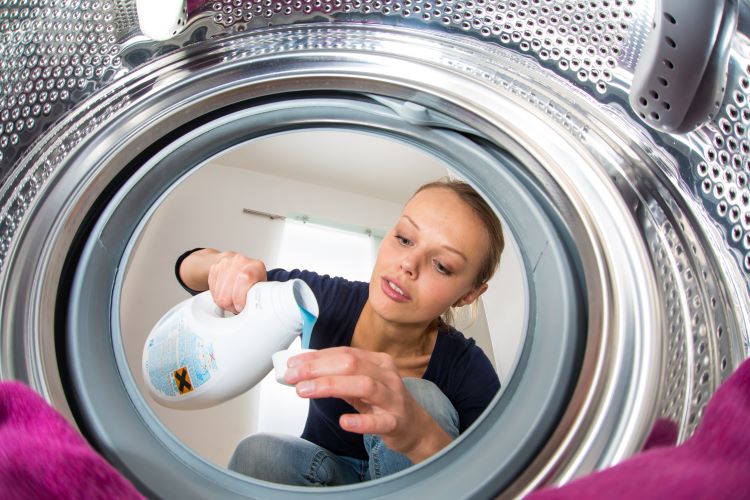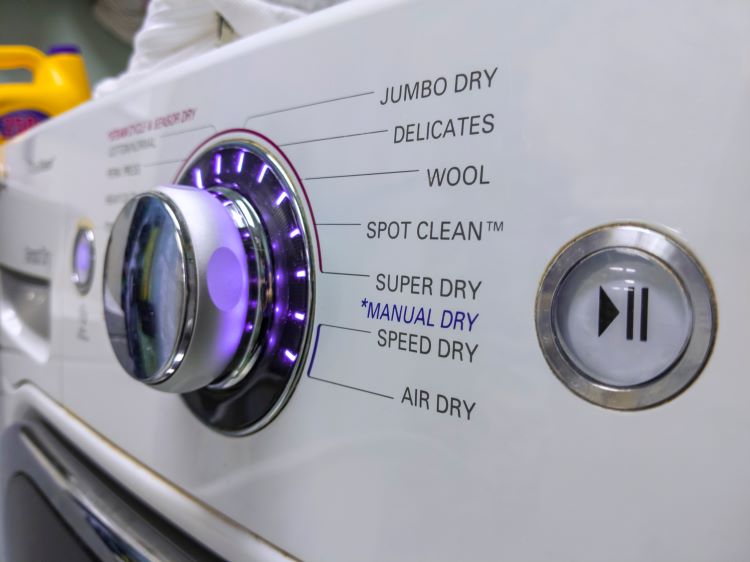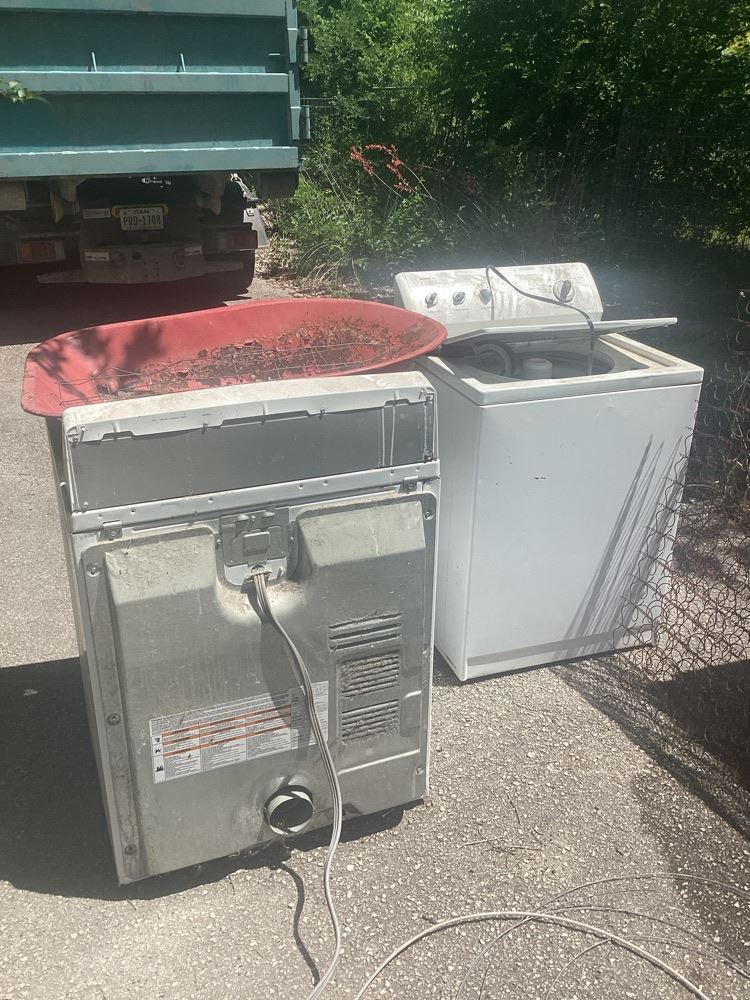How to Save Money and Energy Doing Laundry

It’s summer in the San Antonio area, that hot, humid time of year when simply walking from your front door to your car can turn your clothes into a sweaty mess. Even a sedate picnic in the park means getting drenched in sweat. As does mowing the lawn, playing soccer, taking a jog . . . the list goes on. And don’t even think about the clothes your kids are getting dirty at the playground, the baseball diamond, or in the yard.
All those stinky, sweaty clothes need to be cleaned, and that means more loads of laundry—and more water and electricity. As your washer and dryer swish and fluff your clothes, the meter is spinning away, and no matter where you live—New Braunfels, Schertz, Timberwood Park, or elsewhere in the San Antonio area—you may be shocked when your bills come.
Washers and dryers, according to energy.gov, are among the most energy slurping appliances in your home. Your washer uses about the same energy as your refrigerator, even though it doesn’t run all the time, like your fridge does. And your dryer? It uses more energy than that always-on fridge. If you don’t have a high-efficiency washing machine, you’re also using more water and energy per load. In addition, frequent washing—and making common washing mistakes—is ultimately hard on your wallet because clothes fade and wear out sooner and you have to replace them. Ka-ching!
But you can save money and energy if you’re strategic about how you use your washing machine and your dryer. Here’s how:
WASH SMARTER

GO COLD
Use the cold water setting for most loads. When your water heater has to fire up to make hot water for a load, you’re not only using another appliance, you’re using one that requires a lot of energy—90 percent of the energy it takes to do that load. Save the hot water setting for clothes that are really stained, especially with oil or grease, and for underwear and towels. Even using warm water rather than cold can chop your energy use in half, according to energystar.gov. Skip the ultra-hot, sanitizing option, too, unless you have clothes that are really germy, like diapers or bedclothes and towels used by a sick person.
Want to save even more money? Consumer Reports recommends setting your water heater to 120° F instead of the standard 140° F to pocket up to $400 a year.
CHOOSE THE RIGHT DETERGENT
For cold water washing, go for liquid rather than powder detergents because they dissolve better in cold temperatures and won’t leave a residue on fabrics. Pick detergents specifically formulated for cold water.
Treat a stained item of clothing as soon as possible with the correct stain removal technique. If you get the stain out the first time, you won’t have to rewash the item.
USE DETERGENT THE RIGHT WAY
More soap equals more clean, right? Not necessarily. More soap equals more suds, which makes your washing machine work harder to remove those suds. If your washer has a sensor that detects when clothes need more rinsing, it’ll add rinse cycles that use up more water and energy. And if your washer isn’t very efficient at rinsing, you could end up with residue in your clothes. According to Consumer Reports, all you need for most loads is 1.5 ounces of detergent. NEVER use regular detergent in high efficiency washing machines, which are designed to use less water and need low-sudsing detergents formulated for HE machines.
FILL ‘ER UP
Whether it’s just a few clothes or a whole load of clothes, your washer uses the same amount of energy no matter what the size of the load. Save energy and run only full loads as much as you can.
SPEED UP THE SPIN
Have you ever noticed that, on most machines, you can select the speed at which your washer spins? If your washer offers a high speed spin cycle (or an extra-long spin cycle), use it. It will take more moisture out of your clothes, meaning it’ll take less time for them to dry. Note: high spin is too rough for delicate clothes.
MAINTAIN YOUR MACHINE
To keep from having to call a repairman for expensive repairs or from having to replace a machine that’s beyond repair, keep your washer in good working order.
- Pay attention to the fill line in the tub. Don’t cram in more clothes than your tub can handle.
- Make sure your machine is level. If it wobbles when it spins, then you need to adjust the feet and lock them into place.
- Even out loads that clump on one side. If your top-loading machine sounds like it’s doing jumping jacks, you’ve had a load shift to one side. Make sure the clothes are evenly distributed around the drum.
- Leave the door open after use. Mold can form in the airtight seals of a machine. After a load, keep the door open or ajar to let the machine dry out. From time to time, run the “self-clean” cycle or run an empty load with hot water, a cup of bleach, and an extra rinse cycle. Although you’re using energy and water, you’ll be extending the life of your machine.
DRY SMARTER

HANG IT OUT
Ask yourself if you really need to dry your clothes in a dryer. Sure, a dryer saves you time and gets the wrinkles out, but if you can, hang your laundry outside to dry on a line or use a drying rack inside.
FILL IT UP, BUT NOT TOO MUCH
Crowding clothes into your dryer takes longer for the clothes to get dry. And drying just a few items also takes longer. Drying full but not overfull loads saves the most energy.
SET IT LOW
Using the low heat setting for a longer time saves more energy than drying your clothes on high. Also, use sensor drying rather than timed cycles, because sensors will detect when clothes are dry and shut off the dryer, saving energy. Timed cycles keep the dryer on until time runs out, even if the clothes were dry long before the time was up.
DON’T COOL OFF
If you’re doing more than one load, try to get the second load in while the dryer is still warm from the first one. If the dryer cools off and then has to reheat again, that takes more energy. When you’re on your last load, use the cool-down cycle if your dryer has one, because clothes will finish drying with what heat is left in the dryer.
SEPARATE LOADS BY TYPE
Heavier items like towels and sweatshirts take longer to dry than, say, t-shirts, so if you’re tossing them all together, your shirts are getting dry way sooner than the towels. Save time and energy—as well wear and tear on the fabric—by drying lightweight clothes separately from heavier items.
CLEAN THE LINT FILTER
When a lint filter gets clogged, the dryer has to work harder. Scrape lint off the filter after each load, especially if you use dryer sheets, which produce buildup on filters. Remove that buildup at least once a month, using a toothbrush or other brush to scrub it completely off.
Consider using a wool, plastic, or rubber dryer ball instead of dryer sheets. Dryer balls are reusable, contain no chemicals, and separate laundry as it dries, reducing dryer time. They get rid of static as well as dryer sheets do, but they’re better for the environment because one ball, for example, generally lasts for hundreds of loads. Since the average American family does around 300 loads a year, using a dryer ball makes sense for saving money, time, energy, and waste.
If you notice clothes are taking too long to dry or aren’t getting dry—or if they come out overly hot—then check your dryer vent for dangerous lint buildup or clogs that can lead to dryer fires. If you can’t check the vent yourself, call a professional to service your dryer.
PICK THE RIGHT TIME
Some utility companies hike up their rates for electricity between certain hours, usually during weekday daylight hours, when energy usage is at its highest. Consider doing your laundry at night or early in the morning. Weekends are better than weekdays, too.
BUY SMART
CHOOSE ENERGY STAR
If you’re in need of a new washer or dryer, choose wisely to save both money and energy. Energy Star certified washers use around 25 percent less energy, according to energy.gov, and Energy Star dryers use about 20 percent less. Look for the Energy Star logo on appliances. Gas dryers generally cost less than electric to run, and dryers with heat pumps are up to 28% more energy-efficient than regular dryers.
Although energy efficient washers and dryers may cost a little more than standard models, you’ll make up that cost in energy savings because energy efficient appliances consume ten to 50 percent less energy and water, according to the EPA.
Older appliances also consume more energy, so if your washing machine is older than ten years, it’s likely not as efficient as newer models and could be costing you as much as $210 a year more than an energy efficient model.
WHAT TO DO WITH OLDER MODEL APPLIANCES?

If you’re ready to replace your older model washer and dryer for more energy efficient ones, what do you do with the old ones?
You could donate them if they’re still working, but consider this: that energy- and water-hogging appliance will still be out there, costing someone else money and energy and contributing to greenhouse emissions. The better option is to recycle that washer and dryer or have that appliance disposed of safely and properly.
